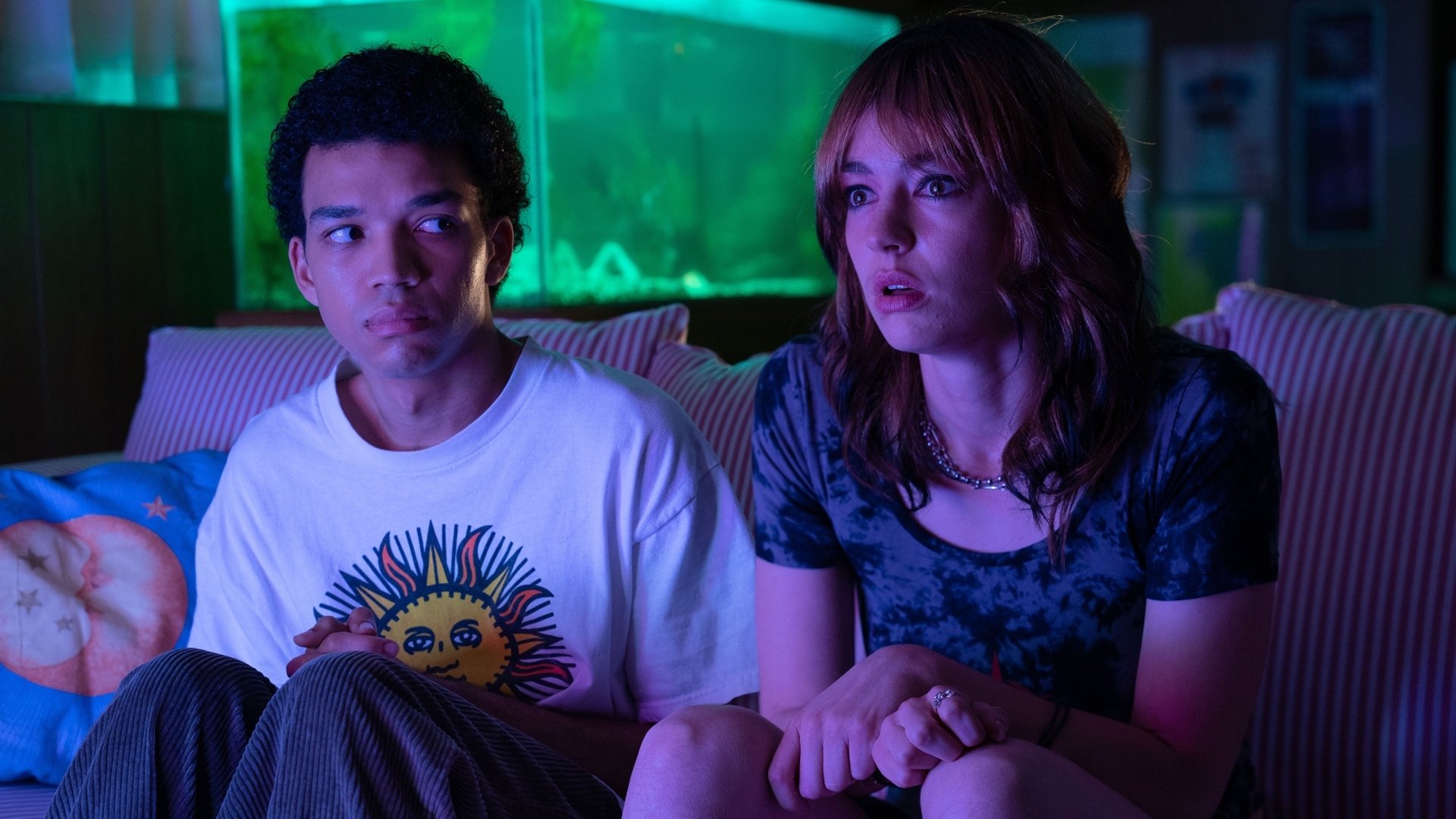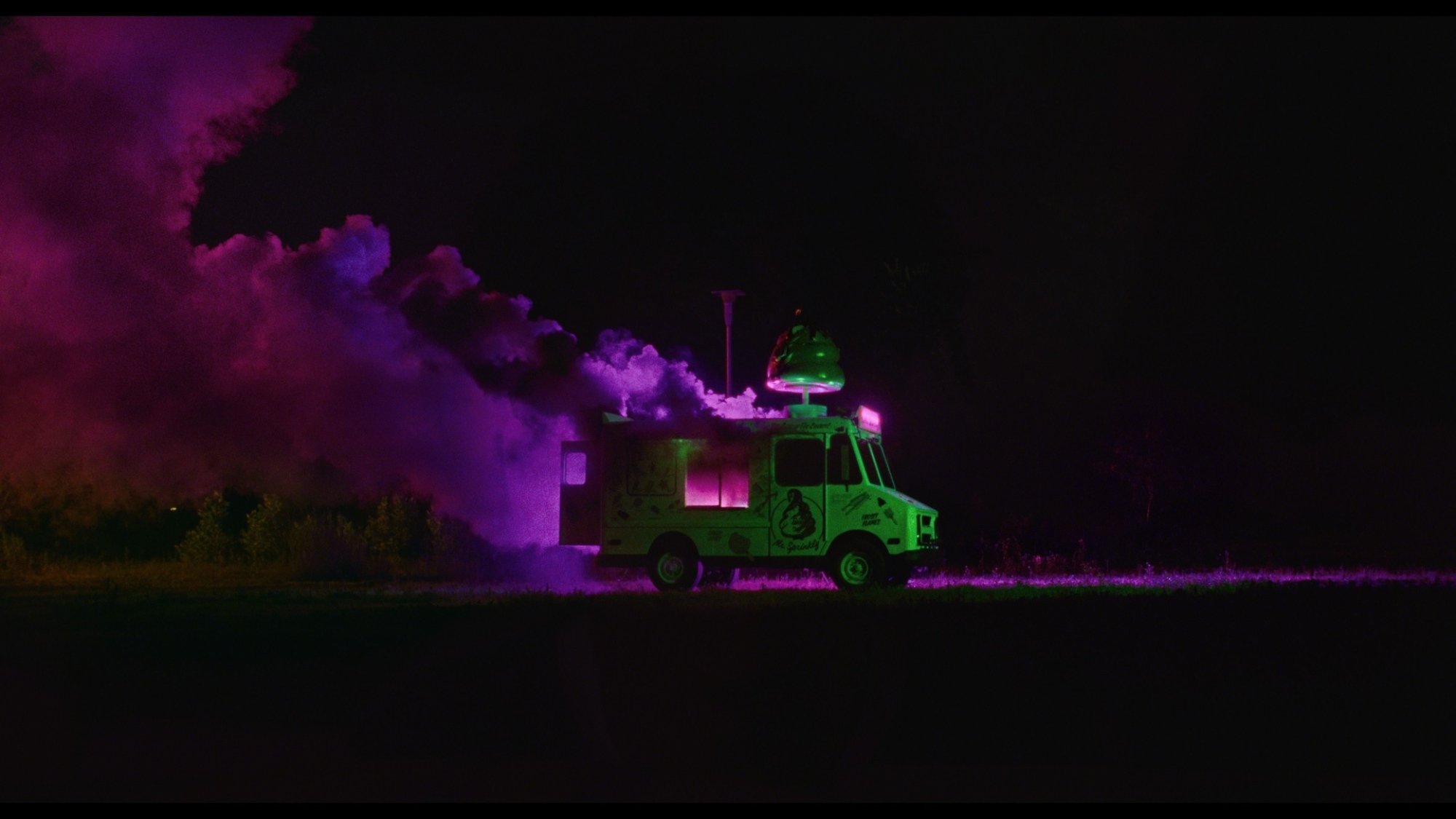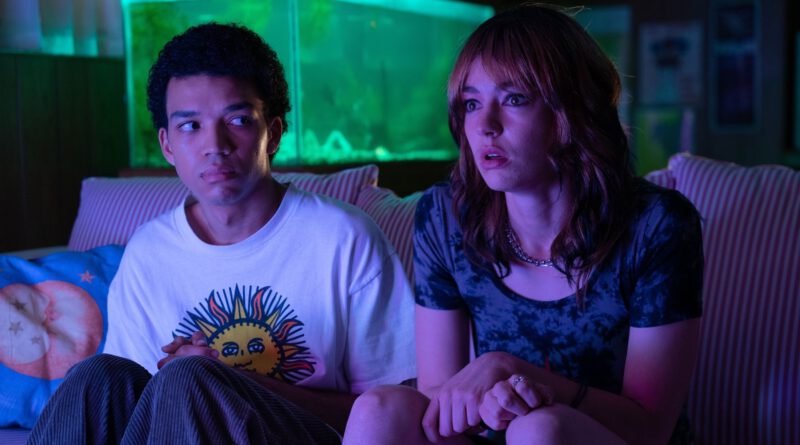‘I Saw the TV Glow’ review: Queer horror has a new arthouse masterpiece

The mysterious allure of stumbling upon some unknown oddity on late-night cable is recreated (and repurposed, to devastating effect) in Jane Schoenbrun’s wildly abstract, masterfully accomplished I Saw the TV Glow. The A24 production is a remarkable follow-up and spiritual companion to Schoenbrun’s Sundance emo-horror breakout We’re All Going to the World’s Fair, a hazy, low-budget indie from 2022 told through late-night vlogs and video chats. The latter was their narrative feature debut, and it captured an online obsession with urban myth that the writer/director used as a vessel for a tale of physical discomfort and social unbelonging. It created, through its subtext and aesthetic approach, a mood comprising the constant, oppressive white noise of gender dysphoria.
I Saw the TV Glow picks up that baton and charges headfirst through the screen. It captures the creeping nostalgia of ’90s children’s and young adult television, as seen through the eyes of two deeply isolated teenagers on arduous, dreamlike journeys of self-discovery. Along the way, the worlds of memory and fiction blur beyond recognition, as the boundary between the characters’ distant observations and intimate bodily experiences shatters completely. The result is a new queer and transgender classic.
While it’s likely to be divisive given its esoteric nature, I Saw the TV Glow proves to be an enrapturing experience if you’re on its wavelength. It’s one of the most overpowering and uniquely despondent works of avant-garde horror to emerge from the American indie scene in several years, making it quite handily the most artistically complete, shatteringly personal movie to play at Sundance this year.
What is I Saw the TV Glow about?
Told initially through childhood memories (and eventually, via first-person recollections delivered to the camera, which hop and skip through time), I Saw the TV Glow provides no temporal anchor for its protagonist, Owen (Justice Smith), a quiet, soft-spoken suburban boy with a doting mother (Danielle Deadwyler) and stern-but-silent father (Limp Bizkit’s Fred Durst). Played as a seventh grader by Ian Foreman, Owen stumbles across the quiet, lonely, self-professed lesbian Maddy (Brigette Lundy-Paine) as she reads the episode guide for her favorite TV show on the floor of their school gymnasium, on the night of 1996 U.S. Presidential election.The Pink Opaque (named for an album by shoegaze pioneers Cocteau Twins) is a low-budget YA action-fantasy that soon becomes Owen’s obsession too.
Each physical space during this introduction — and during the film’s apparent framing device, which is comprised of an older Owen reminiscing about this encounter by campfire — comes wrapped in an eerie hum, accompanied by lights that always seem to flicker. Even when old CRT television sets aren’t part of the mise-en-scène, they’re made to feel ever-present, as though each darkened space were illuminated by the specter of TV, or perhaps its memory.
Maddy, who wears oversized, boyish clothes and has visible hints of peach fuzz on her upper lip, seems initially closed off to Owen’s friendly advances, though she eventually reciprocates upon noticing his interest in the series. The Pink Opaque is the only thing that makes her eyes light up, and over the following years in high school, she leaves Owen taped episodes with hand-written descriptions (his parents won’t let him stay up past the show’s 10:30 p.m. air time).
The atmospheric Buffy-esque series centers on a pair of teenage crime fighters, the carefree Isabel (Helena Howard, Madeline’s Madeline) and the tomboyish Tara (Lindsey Jordan, aka indie rocker Snail Mail), who communicate with each other psychically. Together, they battle the show’s lunar-themed, pointedly named villain Mr. Melancholy. As the years go by, strange, surreal happenings lead to questions about the nature of this series, whether it’s fictional at all, and what mystifying connection Owen and Maddy have to it, since it seems to hypnotize them every time they watch it.
However, these broad strokes are a mere sliver of the bigger picture, a phantasmagorical tapestry laced with static and sadness for which the plot is merely an amoebic, shapeless vessel. It’s a film that lives and breathes through its images and sounds, which come crashing together to create an ethereal collage of feeling cut off from the world, and dissociated from one’s own self — physically, mentally, spiritually — en route to some of the most rousing and disturbing emotional crescendos in recent memory.
I Saw the TV Glow is a major audio-visual triumph.

Schoenbrun, through their commanding use of framing and movement, creates a winding, melodic tunnel for Owen to traverse, and for us to follow him down. There is perhaps no scene more exemplary of this than a lengthy, unbroken shot following Owen down a high school hallway as Maddy’s show notes appear on screen in shiny, pink cursive, while an enveloping electronic track — one of many originals Schoenbrun commissioned for the film — consumes the entire soundscape, echoing endlessly. Owen’s solitude is, in this way, immediately contrasted with Maddy’s intimate, welcoming messages, as though she were sharing a part of herself with him from a distance. But the scene also becomes subsumed by oppressive noise, as though Owen were being robbed of even a single moment of peace or clarity.
The film’s surreal vignettes pull from wistful millennial-tween nostalgia, from the astonishment of witnessing planetarium projections for the first time, to the awe-inspiring wonder of being encased in the airy dome of rainbow-colored playground parachute. But the more Owen and Maddy become absorbed by the story of The Pink Opaque, the more the show’s aesthetic approach begins to blur with real life, and with Owen’s recollections. Clips from the show are presented in a narrow, 4:3 aspect ratio, and with all the mauve and magnetic flaws of something recorded on withered VHS tapes. These segments are so true to the appearance of mid-’90s media that you’d be forgiven for thinking The Pink Opaque was a real show that Schoenbrun had dug up in some dusty archive.
The rest of the film has the appearance of modern “prestige horror,” with its wide frame, warm tones, and impeccably high contrast that makes the world feel obscured by shadow. However, these respective aesthetic fabrics occasionally switch places, as though The Pink Opaque were reality — or vice versa, as though Owen and Maddy’s life had been taped on a VCR. These inversions hint at something amiss and entangled in the ether. As the years go by, they feel betrayed by their childhood memories, until thoughts of escaping — their town, their bodies, their reality — consume their every waking thought.
I Saw the TV Glow isn’t so much a transgender allegory as it is a pure expression of transness in early youth, unfolding at a time and place where words fail, and stories become a medium for not just entertainment but projection, reflection and self-identification. It plays, at times, like a hyper-charged (but deeply considered) suburban, transgender translation of Laura Mulvey’s “Visual Pleasure and Narrative Cinema,” the essay that popularized this multifaceted idea of the cinematic gaze.
This expression, of television as an object of identification, goes hand-in-hand with the movie’s profound sense of loneliness, which invades every carefully composed frame — usually, images of characters at a distance, on their own, hunched up in corners — and every vivacious musical interlude. Some of these are simply live band performances at dingy venues, led by femme and queer musicians trying to express some lurking part of their experience. One impactful scene, intercut with a revelatory conversation between Owen and Maddy, is just a closeup of King Woman’s Kristina Esfandiari screaming for minutes at a time during a music performance, as if trying to expel some wordless, formless embodiment of lifelong isolation.
The movie’s original music, composed by Alex G, effectively captures its story in microcosm, appearing usually during hazy scenes of entranced characters lit by the TV’s pink and purple shimmer. These fleeting moments appear to be the closest Owen will come to understanding something fundamental about himself, at least until he finds a way to break free of his physical, social, and emotional constraints.
Nothing tangible tethers Owen and Maddy to their small town, but demanding tangibility from a film like I Saw the TV Glow is to fundamentally misunderstand not only the kind of movie it is but the intangible nature of the experiences it unearths. It’s the kind of film that, if it speaks to you, is likely to keep you on the verge of tears for all of its 100 minutes, gasping anxiously for breath by the end, feeling like something from deep within you is about to burst forth and see the sun for the first time. And while its success is largely attributable to Schoenbrun’s daring aesthetic introspections as a nonbinary artist, it equally owes its emotional impact to the way they unearth their characters through performance.
Justice Smith and Brigette Lundy-Paine deliver haunting, pained performances.
As a biracial boy in a mostly white town, and a queer, gender-nonconforming teen who uses she/her pronouns, Owen and Maddy make for a fascinating pair of suburban outsiders. Smith and Lundy-Paige (who is nonbinary) craft two of the most fully formed young characters in recent American cinema — at least since Alana Haim and Cooper Hoffman in Licorice Pizza — and they accomplish this by walking a fine and monumentally difficult line.
They’re tasked with not only breaking the fourth wall while maintaining the film’s illusory nature, but also with diving deep into specific high school “types” that could so easily tip over into self-parody if they aren’t modulated correctly. Smith’s anguished conception of Owen — while often perplexed and self-effacing — has a doe-eyed quality that, when coupled with a voice pitched-up nearly to the point of falsetto, pushes its way to the limits of “awkwardness” in the public consciousness. And yet, Smith engenders sympathy through his wayward naïveté. He speaks as though every statement were a question, creating a constant sense of yearning — of searching.
Maddy, on the other hand, seems to know something Owen does not. She appears to hold hints of some sacred knowledge, the details of which she may not be fully certain either, though she’s always one step closer than Owen to a sense of full, luminous, and terrifying discovery. Lundy-Paige’s darting, unblinking eyes dance with the camera, creating a sense of mystery bordering on intentional caricature (as though they were playing the dark-haired, bad boy character Sternum on Moody’s Point, a Dawson’s Creek send-up on the late ’90s Nickelodeon series The Amanda Show). But the more the film goes on, the more natural this heightened performance begins to feel, because of the way Lundy-Paige unfurls Maddy’s fears and insecurities, and the reasons for her sardonic, monotone delivery.
Familiar cultural reference points are unavoidable in I Saw the TV Glow; its own ’90s media is tongue-in-cheek, and the film can be wryly funny as it unpacks the method to its madness. But the more Lundy-Paige sticks with their approach, the more they call the very nature of their performance into question. Maddy is “real,” in the sense that she has presence and corporeal form, but what “real” even constitutes in a media feedback loop — a world of TV teens based on real teens who find identity in fictional form — can be difficult to pin down.
Schoenbrun creates and simultaneously demolishes teenage television archetypes by having their actors lean into familiar cultural shorthands for “awkwardness” — the anxious, self–loathing nerd, and the mean, performative emo girl — until some hidden element of the characters’ reality were unlocked and made wholly unavoidable by the camera’s gaze. If one were to boil it down to literal terms, given what the movie’s textual presentation and the characters’ evolving costume choices, it isn’t hard to surmise that Maddy is further along her queer journey of self-discovery, while Owen tags behind. But to put it so literally, using the language of gradients and spectrums, is to reduce the idea of gender to words and numbers. I Saw the TV Glow, on the other hand, reintroduces it to us using an entirely new cinematic lexicon.
Each time the film filters wordless experiences and self-reflections through familiar linguistic or physical contexts, it’s like antimatter popping into existence before being obliterated by matter all around it, thanks to Smith and Lundy-Paige’s devastating, delicate work. Their performances are both deeply felt and harrowingly embodied. Maddy delivers several lengthy monologues that verge on performance art, as she tries to explain the movie’s strange, surreal happenings to Owen, and to the viewer. But the whole time, her attempts to rationalize her attraction to genre and lore feel as though she’s on the verge of self-discovery — as though she were about to break through the screen and tell us some liberating secret she learned about herself.
Owen, meanwhile, grows increasingly oppressed by the world around him — the four walls of his home, his isolation at school and work, his father’s stoic, masculine expectations — until The Pink Opaque becomes his portal to feeling something different, or anything at all. But when the series’ strange magic begins to infiltrate his surroundings, he’s violently yanked away from his TV at one point (by Durst, who’s terrifying in his imposing silence), causing Smith to let out a bone-chilling wail, just about comprehensible in words: “THIS IS NOT MY HOME.”
Few scenes this year are likely to be as upsetting or impactful, but this is also the very essence of I Saw the TV Glow. It’s an attempt to place years of confusing, festering emotions surrounding unbelonging into something that has shape or form — something that makes sense — but emerges as a desperate, primal scream, exploding with color and shadow. The film is the disturbing sum of its lingering sensations that burrow their way beneath your skin, refusing to leave even after you’ve left the theater, or once you’ve cried yourself to sleep. But at the same time, its totality — the sheer fact of its existence, as an unbridled, uninhibited expression of the self — is exuberant and overwhelming.
I Saw the TV Glow was reviewed out of Sundance 2024.
